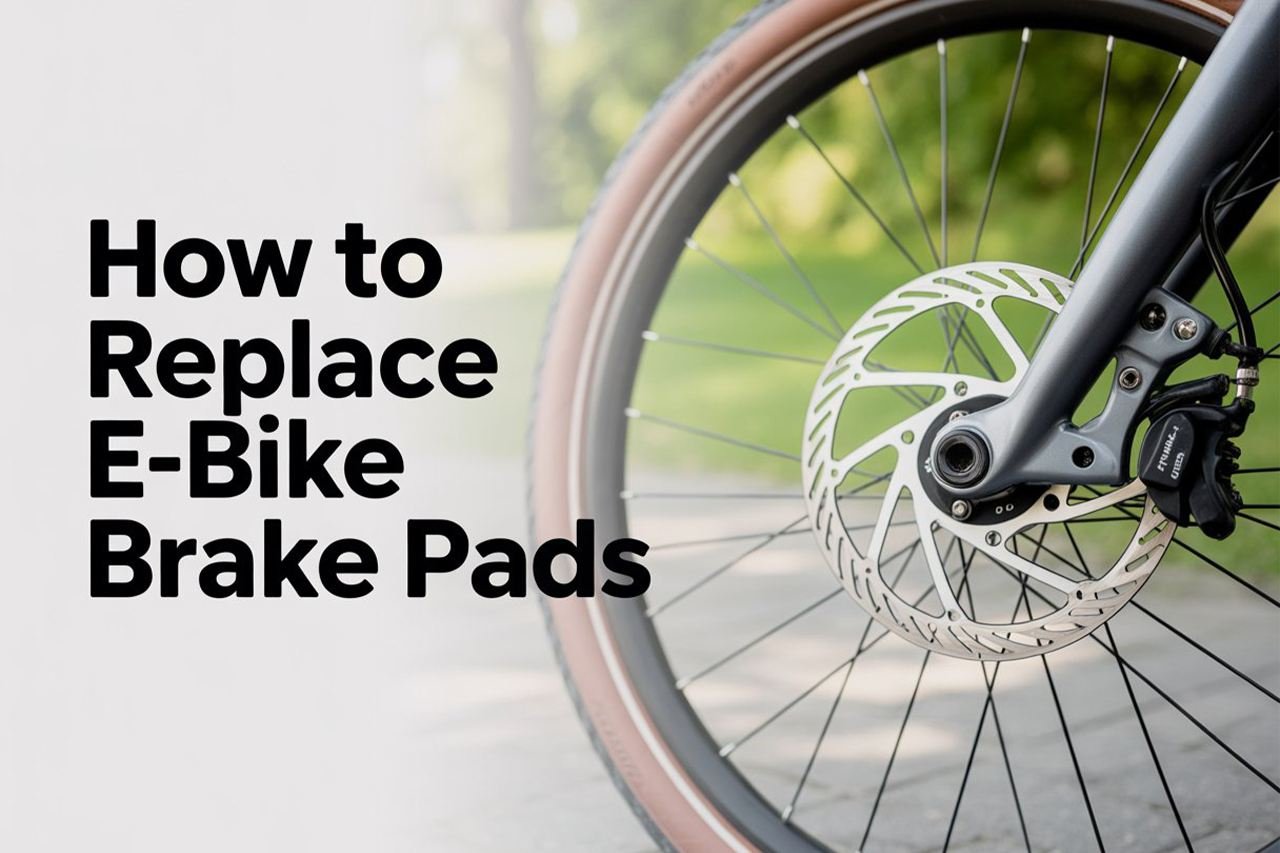
Changing the brake pads on your e-bike may sound intimidating, but with the right guidance, it’s actually a straightforward DIY job that can save you money and keep your rides safe. Whether you’re new to e-bikes or already comfortable with basic maintenance, learning how to replace your brake pads is a must for any responsible rider.
These are the essential steps for replacing your e-bike brake pads:
- Gather your tools and prep your workspace.
- Remove the wheel to access the brake caliper.
- Take out the old brake pads.
- Install new brake pads.
- Reassemble, adjust, and test the brakes.
In the rest of this article, I’ll walk you through each of these steps in detail—complete with pro tips, troubleshooting, and mistakes to avoid. Plus, I’ll explain why timely brake pad maintenance matters, what tools you need, and how to ensure your new pads are working perfectly.
Why Brake Pad Maintenance Matters
Brake pads are the unsung heroes of e-bike safety. Every time you squeeze your brake levers, those small pads clamp down and create friction to slow your wheels. On an electric bike—where you might reach higher speeds or carry more weight than a traditional bike—worn-out brake pads can spell disaster.
Neglecting your brake pads doesn’t just reduce stopping power. It can actually damage other parts, like your rotors (for disc brakes) or rims (for rim brakes), and lead to costly repairs. Worse, you could find yourself unable to stop in an emergency. For commuters, weekend explorers, or city riders, this is a risk you don’t want to take.
Pain point: If you’ve ever noticed your braking feels weak, squeaky, or “gritty,” it’s probably time to swap out those pads. And if you ride daily, in hilly areas, or in wet conditions, your pads will wear out faster than you think. So, let’s get your brakes sorted out before your next adventure!
What You’re Going to Need
Before diving in, let’s make sure you’ve got all the essentials on hand. Here’s what you’ll need for a typical e-bike brake pad replacement:
- New brake pads (make sure they’re the correct type for your brake system: disc or rim)
- Allen wrenches (usually 4mm, 5mm, or 6mm)
- Needle-nose pliers
- Flathead screwdriver
- Bike stand (optional, but very helpful)
- Clean rags or paper towels
- Rubbing alcohol or brake cleaner
- Small brush (for cleaning dust and debris)
- Torque wrench (recommended, for precise tightening)
- Bike grease (optional, for reassembly)
- Gloves (recommended)
- A well-lit workspace
Pro tip: Always double-check your e-bike’s manual for the exact brake pad type and any model-specific instructions.
Video Tutorial
If you’re a visual learner, here’s a concise, step-by-step video that shows the entire process for both disc and rim brake pad replacement on most e-bikes:
How to Replace E-Bike Brake Pads (YouTube Video, 7 min)
This video is an excellent supplement to the guide below, walking through every step with clear visuals and expert commentary.
Step 1: Gather Tools & Prep Your Workspace
Start by getting your bike in a safe, stable position. Ideally, use a bike stand to lift the wheel you’re working on. If you don’t have one, you can carefully flip the bike upside down, but protect the handlebars and seat with rags to prevent scratches.
Remove any accessories (like panniers or fenders) that might get in the way. Lay out your tools within easy reach, and put on gloves to keep your hands clean and prevent oil from contaminating the brake pads.
Tips:
- Working in a clean, well-lit area helps prevent losing tiny parts.
- Keep your new pads in their packaging until you’re ready to install them. Brake pads are easily contaminated by oils from your fingers.
Step 2: Remove the Wheel
For most e-bikes, you’ll need to take off the wheel to access the brake caliper and pads. Here’s how:
- Shift the chain to the smallest cog if you’re working on the rear wheel.
- Release the brake quick-release lever if you have rim brakes.
- For disc brakes, open the quick-release skewer or thru-axle. Hold the bike steady and carefully slide the wheel out.
Disc brake caution: Never squeeze the brake lever when the wheel (and rotor) are removed. This can push the pistons too far out of the caliper, making reassembly a headache.
Tips:
- Place the removed wheel on a clean surface to avoid contaminating the rotor or rim.
- If you’re working outdoors, keep track of any loose axle nuts or washers.
Step 3: Remove the Old Brake Pads
For Disc Brakes
- Locate the small retaining pin, clip, or bolt securing the pads in the caliper.
- Use the appropriate Allen wrench or pliers to remove it.
- Slide the old pads straight out—sometimes you need to gently wiggle or use a flathead screwdriver to nudge them loose.
- Take note of how the pads and spring clip (if present) are arranged. Take a quick photo if you’re unsure!
For Rim Brakes
- Locate the brake shoe (the long black part holding the pad) on each side of the rim.
- Use an Allen wrench to loosen and remove the mounting bolt.
- Slide out the old pad. Some models let you swap only the rubber pad, while others require replacing the entire shoe.
Tips:
- Inspect the old pads for uneven wear, metal showing through, or glazing (shiny, hard surface). These are signs you waited too long!
- If your caliper pistons are sticking out, use a plastic tire lever to gently push them back into the caliper.
Step 4: Clean the Caliper and Rim (or Rotor)
Before installing new pads, make sure the braking surfaces are spotless. Dust, oil, or grime can reduce your stopping power and make your new pads wear out faster.
- For disc brakes, use a small brush and isopropyl alcohol (or brake cleaner) to wipe the inside of the caliper and both sides of the rotor.
- For rim brakes, clean the rim surface and brake shoe holders thoroughly with rubbing alcohol.
Tips:
- Never use lubricants or standard household cleaners—they leave a residue that destroys braking performance.
- Let everything dry completely before proceeding.
Step 5: Install the New Brake Pads
For Disc Brakes
- Align the new pads (with the spring clip if included) so they fit smoothly into the caliper.
- Insert the retaining pin, clip, or bolt to secure them. Tighten snugly—but don’t overtighten!
- Double-check the pads are seated evenly and not rubbing against the rotor.
- If necessary, use the plastic tire lever to gently push the pads apart so the rotor will fit between them.
For Rim Brakes
- Slide the new pads (or pad insert) into the brake shoe or holder.
- Reinstall and tighten the mounting bolt, making sure the pad is aligned with the rim surface and not touching the tire.
- Pads should hit the rim squarely and not extend past the edge.
Tips:
- Some pads are directional—check for arrows or markings before installing.
- Use a torque wrench if possible to avoid stripping bolts.
Step 6: Reinstall the Wheel
Carefully slide the wheel back into place, making sure it sits straight in the dropouts.
- For disc brakes, ensure the rotor slides smoothly between the new pads.
- Reattach the quick-release skewer or thru-axle and tighten to the manufacturer’s specifications.
- For rim brakes, reconnect the brake quick-release lever.
Tips:
- Spin the wheel to check for rubbing or noise.
- If you hear scraping, the caliper may need minor adjustment (see below).
Step 7: Adjust and Test the Brakes
Before riding, make sure your new pads are working perfectly:
- Squeeze the brake lever—there should be firm resistance, not sponginess.
- For disc brakes, center the caliper if needed: Loosen the caliper bolts slightly, squeeze the brake lever, and retighten the bolts.
- For rim brakes, adjust pad angle and position so they strike the rim evenly.
Take the bike for a gentle test ride, braking several times to “bed in” the new pads. This helps them grip better and last longer.
Tips:
- It’s normal for new pads to feel a bit less powerful for the first few stops. After 10-20 firm brakes, they’ll reach full strength.
- Listen for unusual noises—squeaking can mean pads are misaligned or contaminated.
Common Mistakes to Avoid
Even experienced riders sometimes make these mistakes—don’t be one of them!
- Touching the braking surface of new pads or rotors: Oils from your skin ruin their performance. Handle by the edges.
- Forgetting to reset caliper pistons: If they’re not fully retracted, your new pads might not fit.
- Installing pads backwards or upside down: Many pads are directional. Double-check!
- Reusing worn hardware: Always use new retaining pins or clips if supplied.
- Skipping the bedding-in process: This step is vital for optimal braking power and pad life.
Recommended Tools & Accessories
Here are a few tools and extras to make future brake pad replacements even easier:
- Torque wrench: Ensures bolts are tightened to spec—prevents over-tightening or loose hardware.
- Plastic tire levers: Safer than metal for pushing back caliper pistons.
- Disc brake spacers: Handy for keeping pads apart when transporting your e-bike.
- Dedicated brake pad spreader tool: Speeds up pad installation and caliper reset.
- Bike-specific cleaning products: Like disc brake cleaner, isopropyl alcohol, and clean, lint-free rags.
- Spare brake pads: Always keep an extra set on hand, especially if you ride often or long distances.
Final Thoughts
That’s it! You’ve successfully learned how to replace your e-bike’s brake pads—from start to finish. Not only does this save you money, but it’s one of the most empowering and practical skills any e-bike owner can master.
Remember, regular brake maintenance isn’t just about performance—it’s about safety, confidence, and peace of mind on every ride. Don’t ignore the signs of worn pads; swap them out at the first squeak or slowdown. With the right tools and a little patience, you’ll keep your e-bike running smoothly for years to come.
So next time your brakes start to feel sluggish, don’t wait—grab those tools, follow this guide, and get rolling again. Safe and happy riding!
If you need more e-bike how-to guides, product reviews, or expert tips, stick around on GoEBikeLife—your source for all things e-bike!


![The 10-Step Checklist Before Buying Your First E-Bike: A Beginner’s Guide ([year]) Checklist Before Buying Your First E-Bike](https://goebikelife.com/wp-content/uploads/2025/06/Checklist-Before-Buying-Your-First-E-Bike-768x512.jpg)





